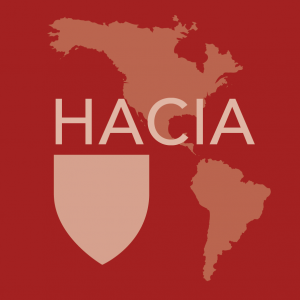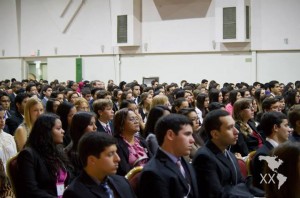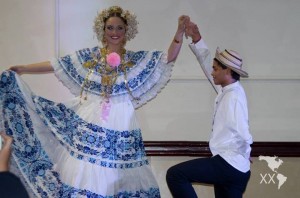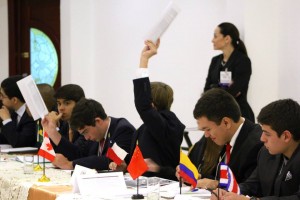
HACIA Democracy is an annual simulation of the Organization of American States (with some specialized committees) that is organized by Harvard University, with this session being held in Panama City, Panama from 13-16 March. This year, I had the honor of participating in the Meeting of Consultation of Ministers of Foreign Affairs of the OAS (MCMFA), a futuristic committee set in the year 2019 with the goal of combating the rise of of civil unrest in Bolivia and dealing with the rise of a new criminal network known as “The5.” What made this experience different from the previous three HACIA Democracy’s that I have participated in was that this year I was not a delegate, but a member of the Junior Staff Program that Harvard offers to allow students to work with Harvard co-chairs in the organization and execution of the committee. It gave me a glimpse on the other side of the curtain when preparing such a prestigious conference and trying to keep a balance between a great debate and a cultural event.
Thursday, the day before the conference began, hundreds of delegates were talking to each other in the halls and lobby of the Hotel El Panamá, making allies and looking for people they would share the next few days with. In all my years of going to HACIA Democracy, never had I seen such a large gathering. It was exciting to see my delegate’s make new friends, and for me, I loved seeing people I had debated with in the past and my old friends from Harvard.
Day one of HACIA Democracy was characterized by a tense atmosphere. Many people who were unfamiliar with each other, all wishing to obtain that highly coveted Best Delegate award.. After an inspiring speech given by former Panamanian President Nicolás Ardito-Barletta, everyone headed to their committee rooms to see their competition. The MCMFA wasted no time in getting started, as the Ministers felt uneasy by the fact that the Minister of Venezuela decided to set up a framed picture of his beloved Hugo Chavez at his seat. Before everyone even had a chance to state their opinion on the picture of the deceased Venezuelan figure, a news report surfaced stating that Venezuela was invading Guyana due to “the Guyanese state’s incapacity to control violence within its borders from spreading.” However, it was believed that the real reason for this invasion was to rid the Americas of the presence of the European Union, who had firmly established itself within Guyana. It took an entire day for the Ministers to develop a plan on how to deal with the invasion and help rebuild the government in Guyana. After a long day of hard work, everyone came together for the Taste of HACIA event, where delegations could share their nation’s cuisine with others. Delicious, free food.
Saturday was not that different from day one for all the committees. In fact, things seemed even more hectic as most delegates did not even take lunch breaks. Instead, I saw dozens of delegates working on resolutions in their committee rooms or even at the lunch tables. The dedication invested into their papers was amazing. After an even longer day of debate than the day before, delegates had the opportunity to relax and enjoy the Talent Show, where participants could show off their unique skills to all their fellow companions. This year, musicians from Guatemala and Panama stole the show!
Little did most delegates know was that shortly after the Talent Show and everyone had returned to their rooms, certain people would be called for an emergency threatening the stability of their nations. People were grabbed from their rooms in the clothes they were wearing shortly after midnight to solve crises in their committees. MCMFA was one of the committee that had to deal with a pressing crisis, consisting of military intervention of Chinese troops in Bolivia to stop the uprising of a deadly secessionist movement. Unlike other committees that managed to solve their issues within about two hours, the delegates of MCMFA worked to create the perfection resolutions – something I personally never had seen before in midnight crises that I had participated in. It took delegates until 4 A.M. to come up with a strategy to deal with this incursion on American sovereignty.
Day three of the conference felt different from the other two. In my case, due to the MCMFA having a midnight crisis, it was particularly short. Delegates returned early in the afternoon, eager to continue on solving pressing matters that threatened the continent. However, the overall mood in the committee slightly changed. While delegates continued to work hard on resolutions, they seemed friendlier with one another, most likely because their time together was coming to an end and they want to make their last memories good ones. With the closing ceremony over, we all had the opportunity to enjoy the last day with our friends at the Delegate Dance.
This year’s HACIA truly brought a fresh breath of air to a conference that I had become greatly familiar with. Instead of having traditional committees modeled after the organs of the OAS and topics that seemed to be solely contained within the Americas, HACIA branched out and experimented with more complex and interesting committees, dealing with issues that I had not even seen. For the first time, the countries outside the Western Hemisphere managed to play a role with committees such as the UN Security Council and MCMFA. The Community of Latin American and Caribbean States explored the intricate relationships and issues that Latin America faces in an environment free of USA. Although these committees may need to be perfected, I believe that if HACIA continues to implement innovations such as these, this conference may be able to break out of using predictable topics and look into menaces that are often overlooked. With this, HACIA may even surpass some of the world’s greatest MUN conferences with its unique agenda.
Pictures owned by HACIA Democracy and Juan Albarran





